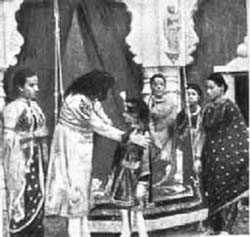Marathi cinema
Marathi cinema refers to films produced in the Marathi language in the state of Maharashtra, India. It is one of the oldest film industries in India, with its origins tracing back to the early 20th century. Marathi cinema has played a pivotal role in the development of cinema in India, known for its innovative storytelling, cultural significance, and the portrayal of real-life issues.
History[edit | edit source]
The history of Marathi cinema dates back to 1913 when Dadasaheb Phalke, also known as the father of Indian cinema, released the first Indian silent film, Raja Harishchandra, which was in Marathi. This milestone marked the beginning of Marathi cinema, which has since evolved through various phases, including the talkies era, the golden age, and into the contemporary period where it embraces new-age cinema and technology.
Golden Age[edit | edit source]
The golden age of Marathi cinema is often considered to be during the 1950s and 1960s when it produced critically acclaimed films that were not only successful in Maharashtra but also gained recognition at national and international film festivals. Films from this era, such as Shyamchi Aai (1953), which won the President's Gold Medal for the All India Best Feature Film, are celebrated for their storytelling, performances, and direction.
Modern Era[edit | edit source]
The modern era of Marathi cinema has seen a resurgence since the early 2000s, with films focusing on diverse themes such as politics, history, romance, and social issues. This period has witnessed the emergence of new filmmakers, actors, and technical excellence, contributing to the industry's growth and global recognition. Films like Sairat (2016) have not only been commercial successes but have also received acclaim for their portrayal of caste discrimination and honor killings, showcasing the industry's ability to tackle complex subjects with sensitivity and depth.
Significant Contributions[edit | edit source]
Marathi cinema has made significant contributions to Indian cinema, both in terms of quality content and pioneering individuals. It has been instrumental in introducing new cinematic techniques, storytelling methods, and addressing themes relevant to Indian society. The industry has also been a launching pad for numerous artists who have made a mark in Bollywood and other film industries.
Challenges and Future Prospects[edit | edit source]
Despite its achievements, Marathi cinema faces challenges such as limited budgets, competition from Bollywood and other regional cinemas, and distribution issues. However, with the advent of digital platforms and the increasing interest of global audiences in regional content, Marathi cinema is finding new avenues for growth and recognition.
Conclusion[edit | edit source]
Marathi cinema, with its rich history, cultural significance, and innovative approach to filmmaking, continues to be an integral part of India's cinematic landscape. As it navigates through the challenges and opportunities of the digital age, it holds the promise of reaching wider audiences and exploring new thematic and narrative territories.
Search WikiMD
Ad.Tired of being Overweight? Try W8MD's NYC physician weight loss.
Semaglutide (Ozempic / Wegovy and Tirzepatide (Mounjaro / Zepbound) available. Call 718 946 5500.
Advertise on WikiMD
|
WikiMD's Wellness Encyclopedia |
| Let Food Be Thy Medicine Medicine Thy Food - Hippocrates |
Translate this page: - East Asian
中文,
日本,
한국어,
South Asian
हिन्दी,
தமிழ்,
తెలుగు,
Urdu,
ಕನ್ನಡ,
Southeast Asian
Indonesian,
Vietnamese,
Thai,
မြန်မာဘာသာ,
বাংলা
European
español,
Deutsch,
français,
Greek,
português do Brasil,
polski,
română,
русский,
Nederlands,
norsk,
svenska,
suomi,
Italian
Middle Eastern & African
عربى,
Turkish,
Persian,
Hebrew,
Afrikaans,
isiZulu,
Kiswahili,
Other
Bulgarian,
Hungarian,
Czech,
Swedish,
മലയാളം,
मराठी,
ਪੰਜਾਬੀ,
ગુજરાતી,
Portuguese,
Ukrainian
Medical Disclaimer: WikiMD is not a substitute for professional medical advice. The information on WikiMD is provided as an information resource only, may be incorrect, outdated or misleading, and is not to be used or relied on for any diagnostic or treatment purposes. Please consult your health care provider before making any healthcare decisions or for guidance about a specific medical condition. WikiMD expressly disclaims responsibility, and shall have no liability, for any damages, loss, injury, or liability whatsoever suffered as a result of your reliance on the information contained in this site. By visiting this site you agree to the foregoing terms and conditions, which may from time to time be changed or supplemented by WikiMD. If you do not agree to the foregoing terms and conditions, you should not enter or use this site. See full disclaimer.
Credits:Most images are courtesy of Wikimedia commons, and templates, categories Wikipedia, licensed under CC BY SA or similar.
Contributors: Prab R. Tumpati, MD


